Ammonites

An ammonoid is an extinct cephalopod mollusk with a flat-coiled spiral shell.
An ammonite may be an ammonoid that belongs to the order Ammonitida, typically having elaborately frilled suture lines.
Mollusks
Def. a "body wall of a mollusc, from which the shell is secreted"[1] is called a mantle.
Def. a "rasping tongue of snails and most other mollusks"[2] is called a radula.
As a mollusk an ammonite may be expected to have
- a mantle with a cavity for breathing and excretion,
- a radula, and
- a structured nervous system.
Cephalopods
An ammonite is expected to have cephalopod characteristics
- bilateral body symmetry,
- a prominent head, and
- a set of arms or tentacles (muscular hydrostats).
Theoretical ammonites
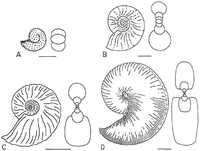
Def. "the scientific study of squid (often extended to all cephalopods)"[3] is called teuthology.
"Teuthology, a branch of malacology, is the study of cephalopods."[4]
Def. "any of numerous flat spiral fossil shells of cephalopods"[5] is called an ammonite.
We "describe the overall mode of growth of ammonoids with reference to Nautilus, the only externally shelled cephalopod that is still extant. Ammonoids are, in fact, phylogenetically more closely related to coleoids than they are to Nautilus (Engeser, 1990; Jacobs and Landman, 1993; Chapter 1, this volume). However, the retention of an external shell in ammonoids implies that these extinct forms shared with Nautilus basic similarities in their processes of growth, although not necessarily a similarity in their rate of growth or age at maturity."[6]
On the right are schematic drawings of four growth stages of Hoploscaphites nicolletii in lateral and transverse cross-sections:
- A is an embryonic shell called the ammonitella, scale bar 500 µm,
- B is the first postembryonic stage called the neanic and the animal or shell is called the neanoconch, scale bar 1 mm,
- C is a juvenile, scale bar 5 mm, and
- D is an adult, scale bar is 1 cm.[6]
Agoniatites
.jpg)
Agoniatites are also known as Anarcestes.
Agoniatites vanuxemi, on the lower right, is the only species of Ammonoid found in the Hamilton Group, Mahantango Formation.
Ammonites
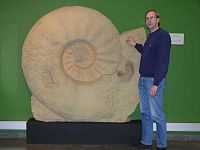
These are ammonites of the suborder Ammonitida.
Ceratites
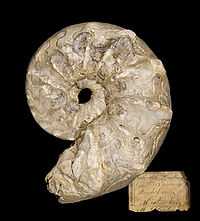
A ceratite may be an ammonoid of an intermediate type, typically with partly frilled and partly lobed suture lines.
"The Ceratitida, which is the dominant ammonoid order of the early Mesozoic and one of the major orders of Ammonoidea, ranged from early Permian to the end of Triassic times, and has an almost worldwide distribution (Hewitt et al., 1993; Page, 1996)."[7]
Clymeniids
Any clymeniid may be an ammonoid with a dorsal siphuncle; i.e., a siphuncle on the inside of the coil rather than the outside.
Goniatites
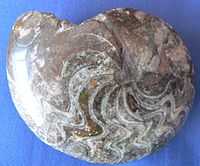
An ammonoid like the one on the right typically with simple angular suture lines is referred to as a goniatite.
Lytocerates
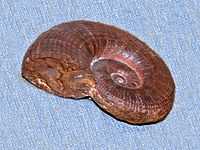
Characteristics:
- loosely coiled,
- evolute,
- gyroconic,
- exposed whorls,
- whorls touching,
- subcircular to narrowly compressed whorls,
- broadly arched, or keeled venter,
- smooth or ribbed sides,
- aptychi are single valved and concentrically striated,
- suture saddle endings tend to be rounded but usually not phylloid,
- lobes tend to be more jagged with thorn-like endings, and
- complex moss-like suture endings with adventious and secondary subdivisions.
Nostoceratids
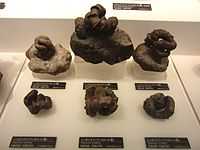
Nipponites mirabilis on the right may be from the Upper Cretaceous.
Phyllocerates
Prolecanites
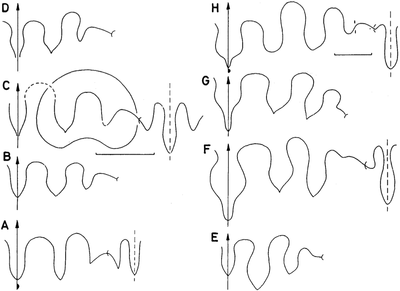
"Type species by original designation of Librovitch 1957, Protocanites supradevonicus Schindewolf (1926)."[8]
In the diagrams above are the suture patterns for various species holotypes:
- A - Protocanites gurleyi (Smith),
- B - Eocanites supradevonicus supradevonicus (Schindewolf),
- C - Eocanites semageominus (House),
- D - Eocanites wangyounensis(Ruan & He),
- E - Michiganites algarbiensis (Pruvost),
- F - Michiganites marshallensis (Winchell),
- G - Michiganites scalibrinii (Antelo),
- H - Michiganites greenei (Miller).[8]
Coleoids
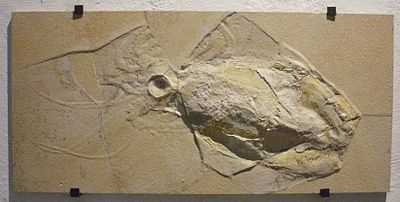
The subclass Coleoidea has the cohort Belemnoidea which may contain shelled cephalopods.
Belemnoids
The cohort Belemnoidea has five extinct orders. Any one of these may contain cephalopods with an external shell.
"Belemnites (Belemnitida) were squid-like animals belonging to the cephalopod class of the mollusc phylum, and therefore related to the ammonites of old as well as to the modern squids, octopuses and nautiluses."[9]
"Now extinct, their fossils are found in rocks of Jurassic and Cretaceous ages, with a few species hanging on into the early part of the Tertiary. The animal’s soft parts very rarely fossilise, leaving us with only the hard parts; the guard and the phragmacone."[9]
Aulacocerids
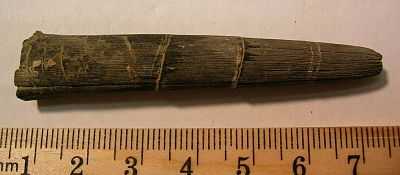
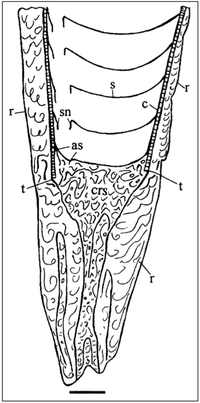
"Pendleian age rocks in the Chainman Shale include the upper beds of the Camp Canyon Member and the Willow Gap Limestone Member. The fossil cephalopods [an example of Hematites barbarae is shown above] are from these rocks in the Confusion Range and Burbank Hills of western Millard County."[10]
For the study of the "shell morphology and ultrastructure in Hematites [more] than 30 specimens of this genus were collected by the second author from the Upper Mississippian in Arkansas. The data obtained confirm the detailed description of the external shell morphology [diagrammed on the right] in the genus published by FLOWER & GORDON (1959) and GORDON (1964), and it also includes new information on the conotheca structure, conotheca rostrum/mantle attachment, “living” chamber length, and morphology of the adoral portion of the rostrum."[11]
"Schematic diagram of the medial shell section in Hematites [on the right shows] the truncation of the initial portion of the phragmocone which is plugged by the central rod structure (crs) and by the additional septum (as). Scale bar: 1 mm. as = additional septum; c = conotheca; r = rostrum; s = septum; sn = septal neck; t = place of truncation."[11]
Phragmoteuthids
The image on the right suggests that Phragmoteuthis conocauda does not have an external shell.
Belemnitids
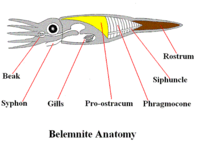
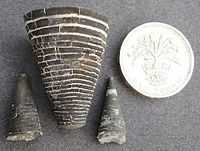
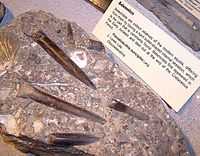
"Belemnites [...] have a worldwide distribution."[12]
Shells or shell-like structures are the phragmacone [in the image on the left] and the rostrum [the second image on the left] which have been found apparently internal to the soft body.
Nautiloids
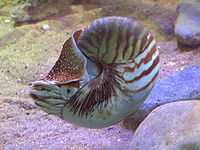
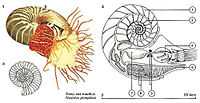
Def. a cephalopod mollusk with a light external spiral shell that is white with brownish bands on the outside and lined with mother-of-pearl on the inside is called a nautiloid.
Nautiloidea is another subclass of cephalopods.
"Nautilus [included in the diagram on the left] is one of the few surviving animals resembling the primitive or original cephalopods. The fossilized shells of these extinct forms, called ammonites (A), are quite common. (B) is a deep-sea species Nautilus pompilius that lives in tropical waters. To the right is a section through Nautilus showing the shell (1) and siphuncle (2) wound in a spiral. Immediately behind the tentacles lies the mouth (4) leading to the intestine (7). Nautilus has an advanced nervous system with a brain (3) and respires by means of gills (6) that are located in the mantle cavity. It swims by forcing a jet of water out of its mantle cavity and through the siphon (5)."[13]
"Nautiluses first evolved in the Cambrian period and became significant marine predators during the Ordovician period."[13]
Nautilids
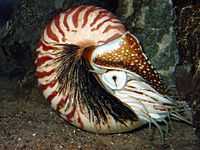
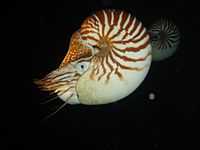
An individual example of the genus Nautilus is on the right.
A couple of Nautilus macromphalus are on the left, photographed during a night dive, at 15 meters, near Lifou, Sandal wood bay, New Caledonia.
"The six living species of nautiluses are:
- No common name (Allonautilus perforates),
- Crusty Nautilus (Allonautilus scrobiculatus),
- Palau Nautilus (Nautilus belauensis),
- Bellybutton Nautilus (Nautilus macromphalus),
- Chambered Nautilus (Nautilus pompilius), and
- White-patch Nautilus (Nautilus stenomphalus)".[13]
Orthocerids
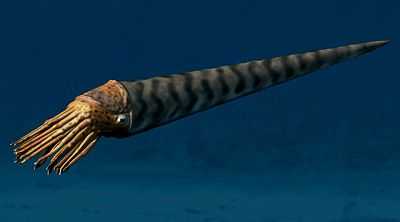
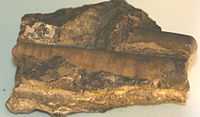
Centered at the top is an artist's impression of an Orthoceras species from the middle Ordovician.
On the left is a fossil of Orthoceras currens.
Anatomy
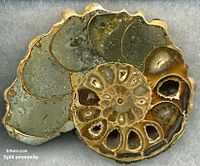
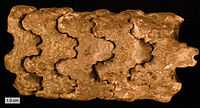
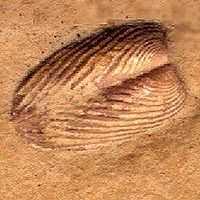
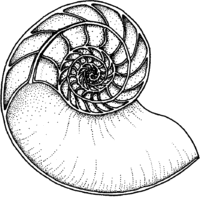
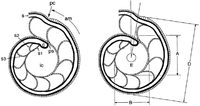
Cut in the plane of the spiral (medial or median cut), the shell reveals the chambers inside.
On the left is an internal mold from a Baculites individual. The original aragonite of the outer conch and inner septa has dissolved away, leaving this articulated internal mold. Baculites is an ammonite from the Late Cretaceous of Wyoming.
The tissue used to close the chamber to the outside is called an aptychus. Perisphictes on the lower left has aptychi.
Agoniatites have a central siphuncle as shown in the illustration on the right with septal necks pointing to the rear (retrochoanitic).
The diagrams on the lower left show median sections where the siphuncle is in a ventral position. Measurements to characterize an ammonite are indicated in the right-hand diagram. The abbreviations are for ammonitella (am), caecum (c), initial chamber (ic), primary constriction (pc), prosiphon (ps), siphunclar tube (s), proseptum (first septum, s1), primary septum (second septum, s2), third septum (s3), maximum initial chamber size (A), minimum initial chamber size (B), ammonitella size (D), and ammonitella angle (E).[7]
Predation
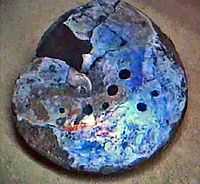
The fossil shell of ammonite Placenticeras whitfieldi shows punctures caused by the bite of a mosasaur.
Sizes
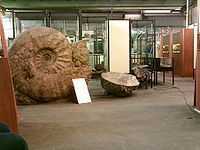
On the right is an image of the world's largest known ammonite, Parapuzosia seppenradensis (originally Pachydiscus seppenradensis) discovered in Seppenrade, Germany. The partial fossil specimen has a shell diameter of 1.95 metres (6.4 ft). But, the living chamber was incomplete. The shell diameter may have been about 2.55 metres (8.4 ft) when it was alive.
Cretaceous
Scaphites hippocrepis is an index fossil for the Cretaceous.[14]
Late Cretaceous
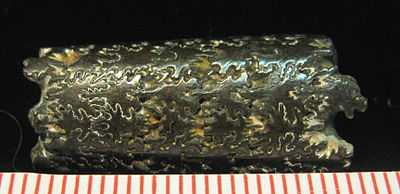

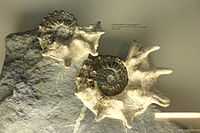
In the top center is a 2.7 cm section of a polished shell with 6 sutures. It is from the extinct cephalopod Baculites compressus; Cretaceous, 100 million years old, Bearpaw Formation, Montana, USA.
The middle center photo is of Baculites ovatus, at the Naturalis Museum, Leiden.
The lower center is a fossil cast of a Baculites grandis shell taken at the North American Museum of Ancient Life.
On the right is an example of Plesiacanthoceras wyomingense from the late Cretaceous in Wyoming, USA. It is exhibited in Smithsonian National Museum of Natural History: Hall of Fossils.
Upper Cretaceous
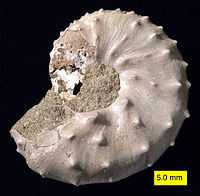
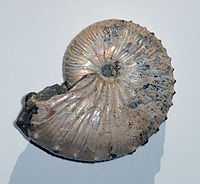
Discoscaphites iris on the right is an ammonite from the Owl Creek Formation (Upper Cretaceous), Owl Creek, Ripley, Mississippi USA.
The specimen on the left is Jeletzkytes spedeni from the Maastrichtian (Upper-Cretaceous) Fox Hills Formation, locality - South Dakota, USA. Matrix free specimen is 7.5 cm (3") in diameter, displaying pearly aragonite preservation of the shell.
Jurassic
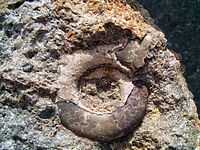
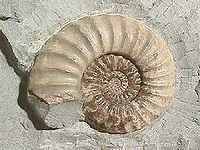
On the left is a photograph of Asteroceras obtusum from the Jurassic Lower Lias Formation, Obtusum Zone. Locality is Lyme Regis, Dorset, England. Complete calcified specimen measures 11.5 cm (4.5") in diameter, in a limestone matrix.
Perisphinctes tiziani is an index fossil for the Jurassic.[14]
Late Jurassic
On the right is an example of Kosmoceras cromptoni from the Late Jurassic, Chippenham, England.
Kimmeridgian
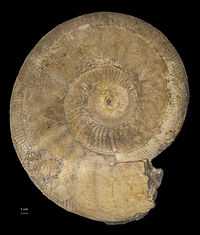
Lithacosphinctes achilles is from the Kimmeridgian.
Callovian
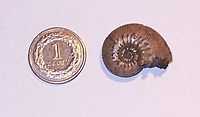
On the right is an image of Peltoceras solidum, an ammonite from the Matmor Formation (Jurassic, Callovian), Makhtesh Gadol, Israel.
On the left is an example of Kosmoceras medea.
Another species of Kosmoceras is on the lower right, specifically Kosmoceras proniae.
Aalenian
Leioceras opalinum is an ammonite from the Aalenian.
Lower Jurassic
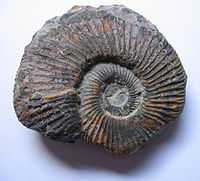
Uptonia jamesoni from the lower Jurassic is in the family Polymorphitidae, superfamily Eoderocerataceae, order Ammonitida, subclass Ammonoidea, class Cephalopoda.
Pliensbachian
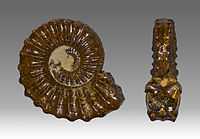
Pleuroceras spinatum (Bruguière 1789) is of the family Amaltheidae. It is a pyritic specimen. The biozone index is to the end of Pliensbachian.
Hettangian
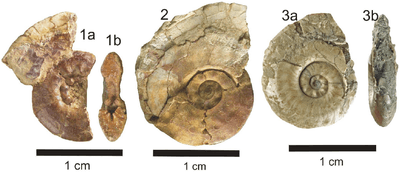
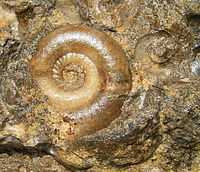
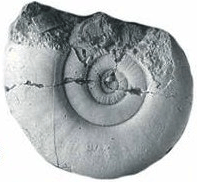
Psiloceras psilonotum, Psiloceras spelae tirolicum and Psiloceras planorbis are from the Hettangian.
Triassic
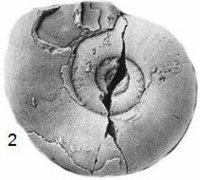
Although the example of Psiloceras tilmanni is from the Jurassic. Its lowest occurrence is in the New York Canyon section of Nevada USA which may be Triassic.
Trophites subbuliatus is an index fossil for the Triassic.[14]
Anisian
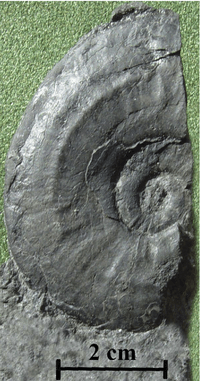
An example of Ussuriphyllites amurensis (Kiparisova) is on the right. It is from the Lower-most Anisian, Atlasov Cape area.[15]
Spathian
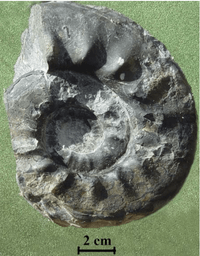
The Spathian is sometimes referred to as the Late Olenekian.[16]
Olenekoceras meridianum is a "typical Late Olenekian [fossil which] differs in its lithology from the same zone of Russian Island, where the Zhitkov Suite has been recognized (Zakharov, 1997; Zakharov et al., 2004)."[15]
Smithian
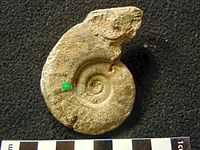
The Smithian is sometimes referred to as the Early Olenekian.[16]
Mississippian
Prolecanites gurleyi is an index fossil of the Mississippian.[14]
Famennian
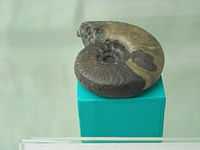
A specimen of Clymenia laevigata from the Upper Devonian Famennian of Poland is on the right.
On the left is a fossil of Platyclymenia intracrostata also from the Famennian of Poland.
Early Devonian
Mimagoniatites is a genus of ammonites from the early Devonian.
"Shell [is] small to large size, evolute, thinly discoidal to discoidal. Whorl cross section of the first two whorls [is] approximately circular, in later whorls subtrapezoidal. Umbilicus [is] narrow to moderately wide, moderately large umbilical window (< 1 mm). Whorl expansion rate increases remarkably from the second whorl on (> 2.5, later up to 3.9). Growth line course [is] biconvex with prominent ventrolateral projection and deep ventral sinus."[17]
The lower boundary of the genus is "LD3C--LD3D: Anetoceras Range Zone top, 405.5 million years" and the upper boundary is "CZB maureri--sulc.antiqua Zone [19,30], 398.5 million years".[17]
Geographic distribution: "Devonian of Algeria (2 collections), Canada (1: Nunavut), China (7), the Czech Republic (5), Germany (3), Morocco (13), the Russian Federation (1), Spain (4), Turkey (3), United States (1: Pennsylvania)".[18]
Silurian
Hexamoceras hertzeri is an index fossil for the Silurian.[14]
Hexamoceras is a genus of the Nautiloidea.[19]
"Rolfe made the important observation that 'Other genera are pre-Devonian and hence cannot be ammonoid aptychi, but Ruedemann's suggestion that aptychi "would naturally also have existed in the Ordovician and Silurian cephalopods" has been largely overlooked'."[20]
Upper Ordovician
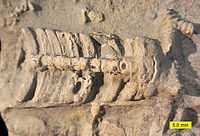
The image on the right is an over-encrusted, internal mold of a nautiloid from the Upper Ordovician of northern Kentucky.
Research
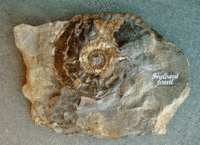
Hypotheses:
- Each of the ammonoids has a set of genes producing a distinct suture mark.
- Ammonoids are alive today.
- Morphological descriptions should be sufficient to identify unknown ammonites at the species level.
Control groups

The findings demonstrate a statistically systematic change from the status quo or the control group.
“In the design of experiments, treatments [or special properties or characteristics] are applied to [or observed in] experimental units in the treatment group(s).[21] In comparative experiments, members of the complementary group, the control group, receive either no treatment or a standard treatment.[22]"[23]
Proof of concept
Def. a “short and/or incomplete realization of a certain method or idea to demonstrate its feasibility"[24] is called a proof of concept.
Def. evidence that demonstrates that a concept is possible is called proof of concept.
The proof-of-concept structure consists of
- background,
- procedures,
- findings, and
- interpretation.[25]
Sciences
Classification of Baculites ovatus:
- Domain: Eukaryota
- Regnum: Animalia
- Subregnum: Eumetazoa
- Cladus: Bilateria
- Superphylum: Protostomia
- Phylum: Mollusca
- Classis: Cephalopoda
- Subclassis: Ammonoidea
- Ordo: Ammonitida
- Subordo: Ancyloceratina
- Superfamilia: Turrilitoidea
- Familia: Baculitidae
- Genus: Baculites
- Species: Baculites ovatus (Say, 1820)
The subclassis: Ammonoidea contains the ordines: Ammonitida, Ceratitida, Clymeniida, Goniatitida, and Prolecanitida.
See also
References
- ↑ "mantle, In: Wiktionary". San Francisco, California: Wikimedia Foundation, Inc. 6 December 2014. Retrieved 2015-04-19.
- ↑ EncycloPetey (7 September 2008). "radula, In: Wiktionary". San Francisco, California: Wikimedia Foundation, Inc. Retrieved 2015-04-19.
- ↑ William C. Summers (1990). Daniel L. Gilbert, William J. Adelman Jr. and John M. Arnold. ed. Natural History and Collection, Chapter 2, In: Squid as Experimental Animals. Springer. pp. 11-25. doi:10.1007/978-1-4899-2489-6_2. ISBN 978-1-4899-2491-9. http://link.springer.com/chapter/10.1007/978-1-4899-2489-6_2. Retrieved 2015-01-31.
- ↑ L. Zawilinski, A. Carter, I. O'Byrne, G. McVerry, T. Nierlich and D. Leu (2007). "Towards A Taxonomy Of Online Reading Comprehension Strategies". University of Connecticut. Retrieved 2015-01-31.
- ↑ Philip B. Gove, ed (1963). Webster's Seventh New Collegiate Dictionary. Springfield, Massachusetts: G. & C. Merriam Company. pp. 1221.
- 1 2 Hugo Bucher, Neil H. Landman, Susan M. Klofak, and Jean Guex (1996). Neil H. Landman, Kazushige Tanabe, and Richard Arnold Davis. ed. Mode and Rate of Growth in Ammonoids, In: Ammonoid Paleobiology. 13. Springer. pp. 407-61. doi:10.1007/978-1-4757-9153-2_12. ISBN 978-1-4757-9155-6. http://www.ammonit.ru/upload/arhiv/bucher-et-al-1996.pdf. Retrieved 2015-04-15.
- 1 2 Yasunari Shigeta, Yuri D. Zakharov and Royal H. Mapes (28 September 2001). "Origin of the Ceratitida (Ammonoidea) inferred from the early internal shell features". Paleontological Research 5 (3): 201-13. http://www.kahaku.go.jp/english/research/researcher/papers/117527.pdf. Retrieved 2015-01-30.
- 1 2 Michael R. House (1994). "An Eocanites Fauna from the Early Carboniferous of Chile and its Palaeogeographic Implications". Annales de la Société géologique de Belgique 117 (1): 95-105. http://popups.ulg.ac.be/0037-9395/index.php?id=1990&file=1&pid=1988. Retrieved 2015-01-30.
- 1 2 Joe Shimmin (2008). "An Introduction to Belemnites". United Kingdom: UKFossils. Retrieved 2015-04-17.
- ↑ J. Kullman, D. Korn, and M. S. Petersen (2000). "Pendleian (Late Mississippian) Cephalopods". Tubingen: GONIAT Database System, version 2.90. Retrieved 2015-04-17.
- 1 2 Larisa A. Doguzhaeva, Royal H. Mapes & Harry Mutvei (February 2002). "Shell Morphology and Ultrastructure of the Early Carboniferous Coleoid Hematites FLOWER & GORDON, 1959 (Hematitida ord. nov.) from Midcontinent (USA)". Abhandlungen der Geologischen Bundesanstalt-A. 57: 299-320. http://www.landesmuseum.at/pdf_frei_remote/AbhGeolBA_57_0299-0320.pdf. Retrieved 2015-04-17.
- ↑ Charles William (2009). "Belemnites". Different Directions. Retrieved 2015-04-17.
- 1 2 3 Liza Carruthers (16 April 2015). "nautilus". The Worlds of David Darling. Retrieved 2015-04-16.
- 1 2 3 4 5 JM Watson (28 July 1997). "Index Fossils". Reston, Virginia USA: US Geological Survey. Retrieved 2015-01-28.
- 1 2 Yuri D. Zakharov, Alexander M. Popov and Galina I. Buryi (April 2005). "Triassic Ammonoid Succession in South Primorye: 4. Late Olenekian – Early Anisian zones of the Atlasov Cape Section". Albertiana 32: 36-9. http://paleo.cortland.edu/Albertiana/issues/Albertiana_32.pdf#page=21. Retrieved 2015-01-24.
- 1 2 Heinz W. Kozur & Gerhard H. Bachmann (April 2005). "Correlation of the Germanic Triassic with the international scale". Albertiana 32 (4): 21-35. http://paleo.cortland.edu/Albertiana/issues/Albertiana_32.pdf#page=21. Retrieved 2015-01-23.
- 1 2 Eichenberg (1930). "Genus Mimagoniatites". GONIAT Online. Retrieved 2015-01-28.
- ↑ John Alroy (2014). "†Mimagoniatites Eichenberg 1930 (ammonite)". Australia: Macquarie University. Retrieved 2015-01-28.
- ↑ IONHexamoceras (15 April 2015). "Name - Hexamoceras". Thomson Reuters. Retrieved 2015-04-15.
- ↑ C. H. Holland (October 1987). "Aptychopsid Plates (Nautiloid Opercula) from the Irish Silurian". The Irish Naturalists' Journal 22 (8): 347-51. http://www.jstor.org/stable/25539196. Retrieved 2015-04-15.
- ↑ Klaus Hinkelmann, Oscar Kempthorne (2008). Design and Analysis of Experiments, Volume I: Introduction to Experimental Design (2nd ed.). Wiley. ISBN 978-0-471-72756-9. http://books.google.com/?id=T3wWj2kVYZgC&printsec=frontcover.
- ↑ R. A. Bailey (2008). Design of comparative experiments. Cambridge University Press. ISBN 978-0-521-68357-9. http://www.cambridge.org/uk/catalogue/catalogue.asp?isbn=9780521683579.
- ↑ "Treatment and control groups, In: Wikipedia". San Francisco, California: Wikimedia Foundation, Inc. May 18, 2012. Retrieved 2012-05-31.
- ↑ "proof of concept, In: Wiktionary". San Francisco, California: Wikimedia Foundation, Inc. November 10, 2012. Retrieved 2013-01-13.
- ↑ Ginger Lehrman and Ian B Hogue, Sarah Palmer, Cheryl Jennings, Celsa A Spina, Ann Wiegand, Alan L Landay, Robert W Coombs, Douglas D Richman, John W Mellors, John M Coffin, Ronald J Bosch, David M Margolis (August 13, 2005). "Depletion of latent HIV-1 infection in vivo: a proof-of-concept study". Lancet 366 (9485): 549-55. doi:10.1016/S0140-6736(05)67098-5. http://www.sciencedirect.com/science/article/pii/S0140673605670985. Retrieved 2012-05-09.
External links
![]() This is a research project at http://en.wikiversity.org
This is a research project at http://en.wikiversity.org
| |
Educational level: this is a research resource. |
| |
Resource type: this resource is an article. |
| |
Resource type: this resource contains a lecture or lecture notes. |
| |
Subject classification: this is a Geology resource. |